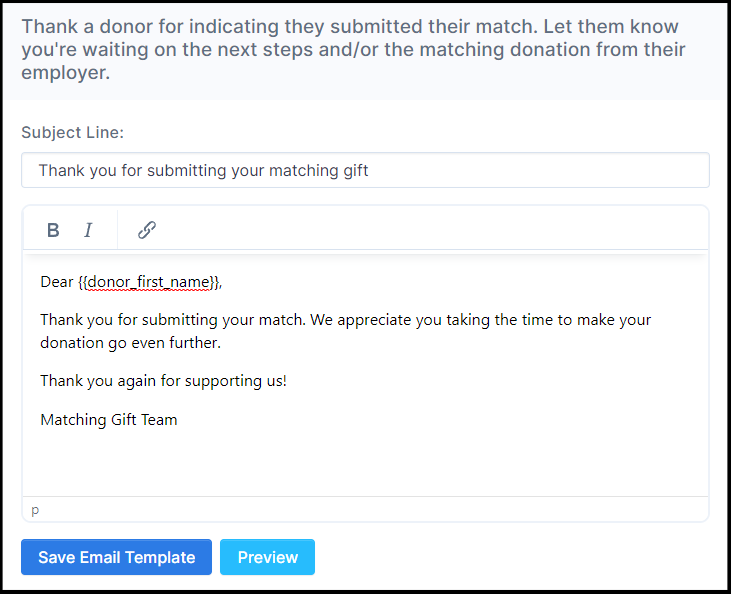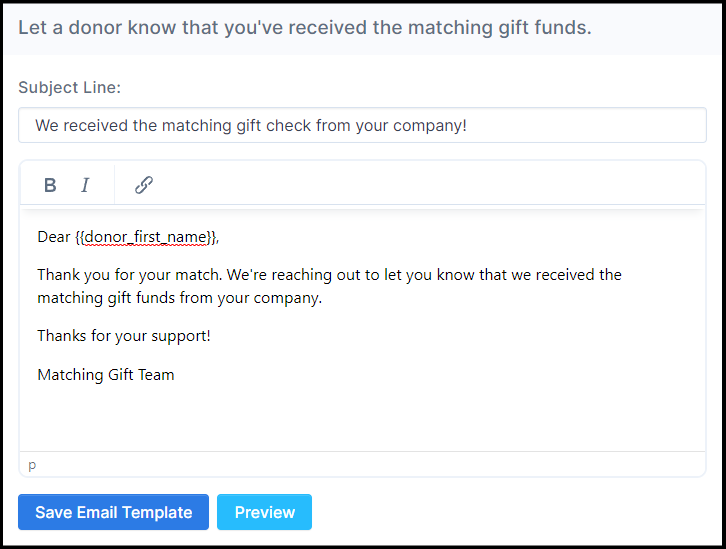Configuring Manual Email Templates
This article walks through the different manual email templates, how we recommend using the templates, and how to create custom templates. This is available for Double the Donation Matching.
2. Let a donor know that you've received the matching gift funds.
6. Email a donor and ask them to see if their employer will match their gift.
8. Email a donor to encourage them to submit their match before your Fiscal Year ends.
Training Video: Understanding Manual Outreach
Manual Outreach
After a donation enters Double the Donation Matching, it first moves through the Automated Outreach stream. Automated messages help identify match-eligible donors and guide them through their employer’s matching process.
Most automated emails conclude 30 days after the donation enters the system.
Once automated outreach finishes, your team can follow up using Manual Outreach.
Two Types of Manual Outreach
-
Default Templates
Prebuilt templates for the most common donor scenarios. -
Custom Templates
Build and save your own templates to use in one-off or bulk emails.

Default Template
Double the Donation provides eight recommended templates. Each template corresponds to a specific donor scenario and includes recommended email variables.
You can edit these email templates and send a matching gift email manually to one specific donor or multiple donors at a time. We've created 8 scenarios where you can follow up with donors after they've received automated emails.
Below is a structured explanation for each template:
Template 1 — Thank a donor for indicating they submitted their match. Let them know you're waiting on the next steps and/or the matching donation from their employer.
When to Use
Send to donors in Match Initiated status who indicated they submitted their match request.
Purpose
-
Reinforce donor appreciation
-
Confirm next steps
-
Keep them engaged through the final match outcome
Recommended Variables
- {{donor_first_name}}

Template 2 — Let a donor know that you've received the matching gift funds.
When to Use
After your organization receives the company’s matching gift payment.
Purpose
-
Close the loop with the donor
-
Show transparency and gratitude
Recommended Variables
- {{donor_first_name}}

Template 3 — Let a donor know that you verified their gift and that you're waiting on their employer to send the matching gift funds.
When to Use
After verifying the donor’s original gift in a company’s portal.
Purpose
-
Confirm verification
-
Inform donor that the employer’s payment is pending
Recommended Variables
- {{donor_first_name}}

Template 4 — Thank a donor even though their gift likely can't be matched and propose alternate ways to get their company involved.
When to Use
For donors marked Ineligible, either automatically or after employer review.
Purpose
-
Maintain stewardship
-
Offer alternative corporate engagement paths (volunteering, sponsorship, grant programs)
Recommended Variables
- {{donor_first_name}}

Template 5 — Let a donor know that their employer will likely match their gifts, and ask them to submit the match.
When to Use
For donors who work for a company with a matching program but haven’t identified whether they submitted a match request.
Purpose
-
Reinforce matching eligibility
-
Provide direct steps to submit the match
Recommended Variables
-
{{donor_first_name}}
-
{{donation_amount}}
-
{{form_available_link}}
-
{{indicate_match_submitted_link}}
-
{{indicate_ineligible_link}}
-
{{matched_company_info}}

Template 6 — Email a donor and ask them to see if their employer will match their gift.
When to Use
For donors in Employer Identification in Progress who didn’t search for their company via the plugin.
Purpose
-
Motivate donors to search for their employer
-
Increase match-eligible identification
Recommended Variables
-
{{donor_first_name}}
-
{{plugin_link}}
-
{{indicate_match_submitted_link}}

Template 7 — Email a donor and ask them to see if their employer will match their gift before your Fiscal Year ends.
When to Use
For donors in Employer Identification in Progress at fiscal year end.
Purpose
-
Urgent reminder before year close
-
Increase last-chance identification and submissions
Recommended Variables
-
{{donor_first_name}}
-
{{donation_amount}}
-
{{donation_date}}
-
{{plugin_link}}
-
{{indicate_match_submitted_link}}
-
{{indicate_ineligible_link}}

Template 8 — Email a donor to encourage them to submit their match before your Fiscal Year ends.
When to Use
For Waiting for Donor records at fiscal year end.
Purpose
-
Urgent reminder to submit match
-
Designed for donors who already work for a matching gift company
Recommended Variables
-
{{donor_first_name}}
-
{{donation_amount}}
-
{{donation_date}}
-
{{form_available_link}}
-
{{indicate_match_submitted_link}}
-
{{indicate_ineligible_link}}
-
{{matched_company_info}}

Custom Templates
You can create and save fully customized templates for one-off messages or bulk outreach.
Navigation
Manual Outreach → Custom Templates → Create New Template

How to Create a Custom Template
-
Name the template
-
Create the subject line
-
Write the body text
-
Insert email template variables as needed
-
Click Save Email Template
-
Preview your template using the Preview button before sending
For more information on sending manual emails, visit this article.
